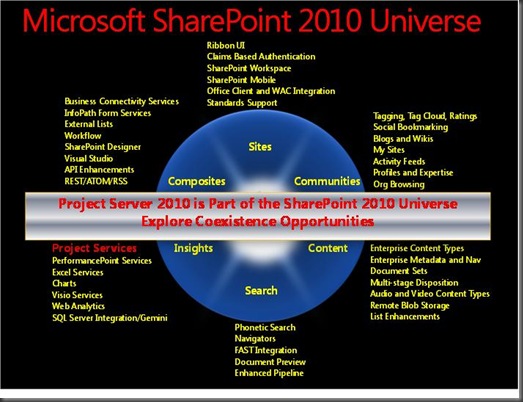Project Server 2010 coexisting in SharePoint Server 2010 Universe
Project Server 2010 coexisting in SharePoint Server 2010 Universe
In May 2009, a whitepaper titled EPM and Office SharePoint Server 2007 Coexistence — Intranet Scenario was released.
The whitepaper outlined the recommended setup and configuration approach for an Enterprise Project Management(EPM) focused Microsoft Office SharePoint Server 2007 Intranet farm. It also provided a set of validated and tested best practices for Office SharePoint Server 2007 and EPM coexistence.
Rewind 6 months forward and let’s have a look at the above paper again, this time through the lenses of new SharePoint Server 2010 platform. What is different, you may ask. With the new SharePoint Server 2010 platform that is now a requirement for Project Server 2010, how has this concept of “coexistence” changed?
What remains the same?
Similar to EPM and Office SharePoint Server 2007 deployments for coexistence, deploying Project Server 2010 and SharePoint Server 2010 solutions together in a single farm that enhances EPM users experience and provides full, seamless coexistence of all logical components and feature areas presents additional challenges and complexities.
New SharePoint Server 2010 platform offers many feature areas, such as Excel Calculation Services, Visio Services, Web Analytics and others that may be of interest when implementing a robust, integrated EPM solution.
What changed?
The new SharePoint Server 2010 Enterprise Edition is now a requirement for running Project Server 2010 and no longer optional. For all practical purposes Project Server 2010 became SharePoint 2010 application. Also, the basic coexistence scenarios one needs to consider changed somehow. The two scenarios that need to be evaluated are:
- Deployment of a new EPM focused farm with Project Server 2010 and SharePoint Server 2010
- Deploy a new Project Server 2010 into an existing SharePoint Server 2010 farm accommodating and coexisting with multiple feature areas
The first scenario allows maintaining exclusive EPM focus and activating only services that are necessary to provide EPM centric features and capabilities. Architecture, capacity planning and design activities can focus strictly on supporting and delivering EPM solution centric requirements.
The minimal set of services required to operate a Project Server 2010 server farm are:
- Project Service Application -required to host one or more Project Web Access instances
- Excel Services - required for reporting
- PerformancePoint Service - required for reporting
- Secure Store Service – required for reporting and data level impersonating
- State Service – required for charting in the Portfolio and Resource features
The second scenario, depending on the mission (focus) and architecture of the existing SharePoint Server 2010 farm, can prove to be a lot more challenging to plan and architect for. The picture below shows many feature areas available as part of SharePoint Server 2010 platform.
A unique load profiles and characteristics of EPM solution need to be defined and their potential impacts on the existing SharePoint 2010 architecture evaluated. The original capacity planning and design assumptions need to be reviewed to determine if the changes to the existing SharePoint 2010 farm architecture are necessary prior to adding Project Server 2010 to the farm.
To provide more prescriptive guidance and validate SharePoint 2010 feature areas for coexistence with Project Server 2010, a new “EPM and SharePoint Server 2010 Coexistence — Intranet Scenario” white paper will be released in first half of 2010.
As a start, the following SharePoint Server 2010 feature areas and services will be validated for coexistence with Project Server 2010:
- Search
- Enterprise Search center
- Fast Search Center
- MySites
- Enterprise Content Management
- Document Center
- Records Center
- Office Client integration
- Collaboration and Workflow
- Business Connectivity Services
- Business Intelligence
- Excel Services and PowerPivot
- PerformancePoint Services
- Visio Services
- SharePoint and Project Server Web Parts
- Health and Monitoring
- Backup and Restore
System Components testing will include functional testing of main logical architectural components of SharePoint Server 2010 and Project Server 2010 such as Site Collections, Application Pools, Content Databases and PWA Instances.
Finally, let me just say this. The new SharePoint Server 2010 Universe is bigger and more complex. With Project Server 2010 now being the part of that Universe, we need to figure out what is the best way to coexist, what new frontiers we can explore and take advantage of while not disturbing or upsetting the balance of “SharePoint 2010 planetary systems” already in place. Then, we can deliver on the promise of providing more complete, richer and more integrated platform for our end users.
All the best in 2010 and look for EPM and SharePoint Server 2010 Coexistence - Intranet Scenario whitepaper coming soon.
